The diversity of climatic zones in our country allows us to grow different varieties of tomatoes in the soil. But still, in most of Russia, cultivation of crops in open beds is limited. Planting tomatoes in open ground is practiced mainly in the southern regions
How to properly grow tomato seedlings read this article
| Content:
|
Varieties for open ground
The choice of variety depends on the growing region.
In the north, tomatoes are planted only in a greenhouse, since not a single variety, even an ultra-early ripening one, will have time to produce a harvest in a short summer.
The ripening period for early tomatoes is 80-100 days. These are usually determinate tomatoes; mid-season and mid-late varieties 100-120 days (determinate and indeterminate tomatoes); later - more than 120 days (usually indeterminate tomatoes, although there are also determinate varieties).
Varieties for the northwestern regions
On northwest Tomatoes of ultra-determinate (super-determinate) varieties are planted in the ground. These are low-growing, early-bearing plants that lay 2-3 flower clusters, after which they emerge and no longer grow upward. These tomatoes do not grow by stepsons, since the crop is formed only on the stepsons.
The first flower cluster is laid after 3-4 leaves, and the subsequent ones - after 1-2 leaves. Ripening time is 85-95 days. The fruits are small. However, in cold years the crop does not ripen; tomatoes are affected by late blight very early. Therefore, even when planted in open ground, tomatoes are kept under cover.
The most suitable varieties: Aurora, Aksanta, Aphrodite, Bystryonok, Izyuminka.
Tomato varieties for planting in the middle zone
Superdeterminate and determinate tomatoes are grown in open ground. Determinate varieties plant 5-6 clusters, after which a flower cluster is formed at the top of the bush and their growth is completed. The first brush appears after 6-7 leaves.
They are quite cold-resistant (withstand temperatures of 12-15°C), but in cold weather they are kept under cover.Form into two stems, leaving a stepson that appears in the axil of the second leaf. If the summer is warm, then only a small number of stepsons are removed, allowing the bushes to branch; in August it will be possible to harvest a second wave of harvest from them.
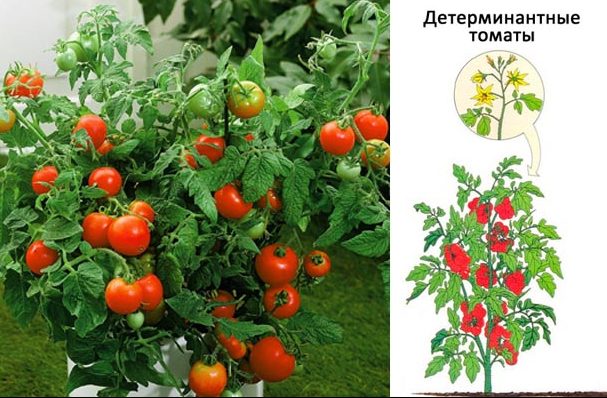
Determinate tomatoes
In cold summers, all the shoots are removed, leaving two stems, otherwise you may not get a harvest. Compared with indeterminate varieties The yield in children is lower, but the difference can only be assessed in the southern regions, since indeterminate tomatoes do not have time to reach their potential in the middle zone.
Determinate tomatoes come in small, medium and large varieties. However, in the Non-Black Earth Region they do not grow to the mass declared by the originator, since they lack food and warmth.
Indeterminate tomatoes will not have time to ripen even at an average ripening time in open ground in the middle zone.
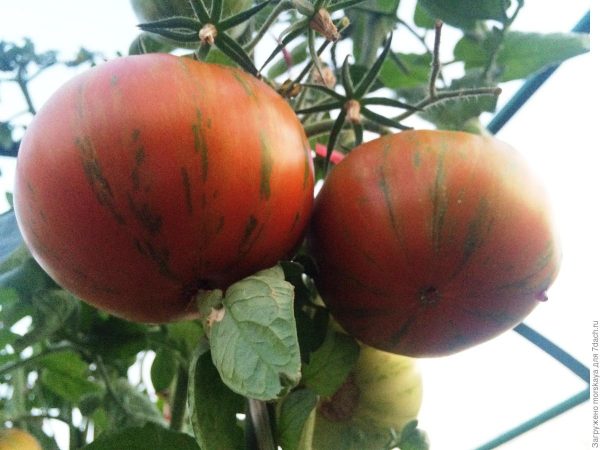
Amur tiger
Recommended varieties for planting: Amur Tiger, Spring Frosts, Gravity, Ground-6, Leader of the Redskins, Flash, Buyan, Pink Souvenir.
Varieties for the southern regions
In the south, almost any tomatoes are planted in the ground, including indeterminate varieties, since the summer is warm and long and the tomatoes have time to ripen. They grow especially well in Crimea, Kuban, and the Black Sea coast.
Indets are tomatoes with unlimited growth. Without pinching, they grow like vines, laying flower clusters through 3 leaves. Fruiting occurs later, but lasts until frost or until the bushes become sick.
They grow in one, sometimes two stems. During prolonged warm weather, several stepsons are left, from which the third or fourth wave of the harvest is obtained. Indeterminate tomatoes in the majority large-fruited, but there are also medium-fruited varieties.
Tomato varieties for planting in the ground in the southern regions:
- Determinate varieties: Firewood (late-ripening), Pickling delicacy, Indigo rose (withstands short-term frosts down to -5°C), Pupsiki, Tiger plum.
- Indeterminate varieties: Wine Jug, Little Fox, Golden Rain, Cardio, Sprint Timer.
These varieties can be planted further north, but there they are still better grown in greenhouses.
Planting of hybrids in open ground is carried out only in the southern regions. In the middle zone and to the north they lack sun, warmth and nutrition, so they often fail there.
In the southern regions, early, middle and late varieties are grown, in the middle zone and in the north-west - early varieties; Even medium-sized tomatoes in the ground may not ripen here.
Preparing the bed for planting seedlings
The choice of location for planting tomatoes depends on the growing region. In the northern regions, this should be the sunniest place; in the shade, the crop will not produce a full harvest. In the south, tomatoes are planted in the ground so that they are in the shade for part of the day, since the burning sun bakes the plants.
- The best predecessors are legumes (peas, beans, beans)
- Good - carrots, beets, cucumbers, greens
- It is not advisable to plant the crop after peppers and eggplants
- It is forbidden to plant tomatoes where potatoes grew last year.
Tomatoes love fertile soil, so they always grow better on black soil. When preparing the bed in the fall, you can add fresh manure to the soil, 2-3 buckets per m2, since it will rot over the winter. Be sure to apply phosphorus fertilizers (2-3 tbsp/m2), since tomatoes consume it in large quantities.
In the spring, add compost or humus. If there is no organic matter, then use the soil for tomato seedlings.If the amount of fertilizer is limited, they are applied directly into the hole when planting (except for fresh manure). Fresh manure and ash are applied at different times, since they cannot be applied together. If fresh manure (and half-rotted manure too) is applied in the fall, then the ash can only be used in the spring.
Peat should not be used in beds with tomatoes, as it acidifies the soil and inhibits the growth of the crop.
Planting tomato seedlings
To avoid late blight affecting tomatoes, they should not be planted next to potatoes.
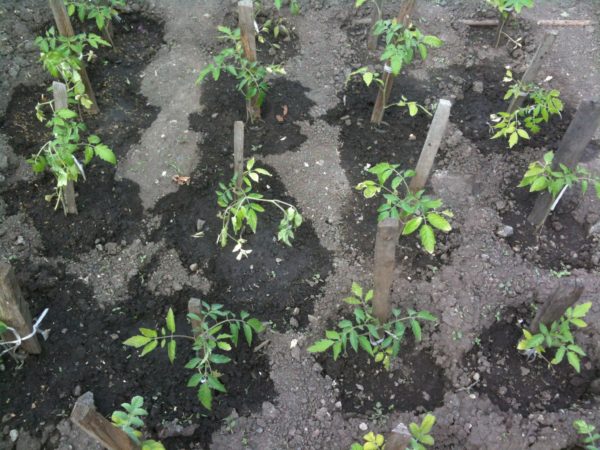
After transplanting the seedlings into the ground, water it abundantly.
Tomatoes are planted in open ground when the temperature at night is above 7°C. In cloudy weather, work is carried out in the first half of the day, in sunny weather - in the second.
The holes are filled with water before planting, and after absorption, the water is filled again, then the seedlings are planted. Immediately after planting, the tomatoes are watered again. If the seedlings are well developed, then they are planted vertically, deepening the stem by 7-10 cm. If they are very elongated, they are planted lying down, leaving the crown 15-20 cm uncovered.
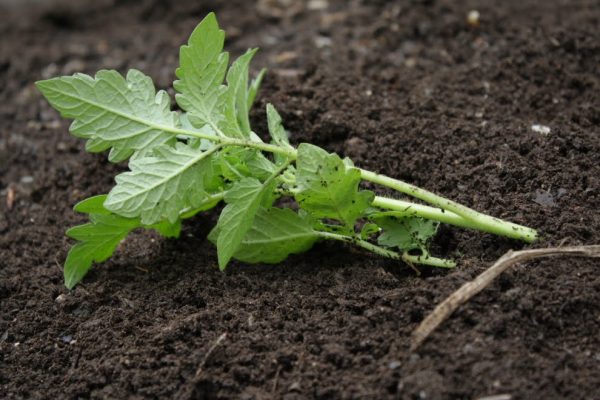
In a few days this tomato will already be growing vertically.
Immediately after transplantation, this crown does not need to be tied to pegs; it is easy to break. After a few days, the plants will take root and raise their heads on their own. This will happen even faster if the tomatoes were planted with their heads facing north, then the plants will reach towards the sun and rise quickly.
Scheme for planting tomatoes in the ground
Low-growing determinate tomatoes are planted either in 2 rows or in a checkerboard pattern. The row spacing when planted in rows is 60-70 cm, and between plants is 40-50 cm. When planted in a checkerboard pattern, the distance between plants is 50-60 cm. Ultradeterminate tomatoes are planted at a distance of 30-40 cm from each other.
Covering plants after transplantation
After transplanting in cold weather, the tomatoes are covered with film or lutarsil. In the absence of covering material, they are insulated with hay, straw, and sawdust. When the daytime temperature reaches 17-18°C, the covering material is removed.
If severe frosts are expected, the tomatoes are covered with a double layer of spunbond, additionally insulating them with hay.
In the middle zone and in the north-west, it is not recommended to remove spunbond or film in the summer, since at night the temperature is often 12-13°C even in July. In the south, covering material is removed when the temperature at night is at least 15°C. At temperatures below 10°C, tomatoes stop growing, so they must be covered in cold weather.
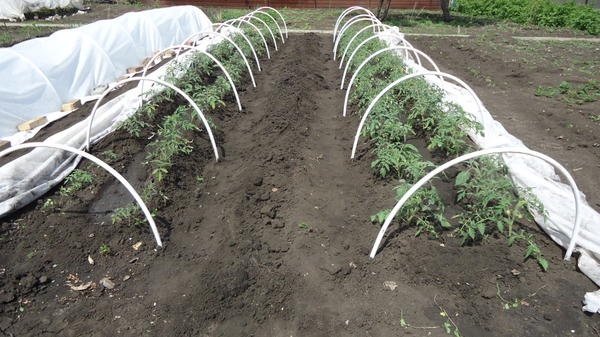
The planted seedlings are covered with spunbond
Tomato seedlings planted in open ground are shaded from the bright sun for several days.
Planting tomatoes with seeds in the ground
This planting method is practiced only in the south: in the Krasnodar Territory, Crimea, and the Caucasus. In the northern regions, it is unacceptable, since sowing tomatoes, even under film, is possible no earlier than mid-May, when home seedlings are already planted in the beds. With this method, by the end of summer, the tomatoes, at best, will have two flower clusters, and the fruits will not have time to ripen or even set.
In the south, seeds are sown in the ground when the soil temperature is at least 15°C. Usually this is the end of April - beginning of May. The soil for planting is prepared in the same way as for seedlings. For direct sowing of seeds in the ground, only early ripening determinate and semi-determinant varieties are taken.
Seed preparation
Before planting, tomato seeds are processed, as when sowing seedlings.
- Etching. Soak for 30 minutes in a pink solution of potassium permanganate or keep in water at a temperature of 53°C for 20 minutes.
- Germination. The seeds are wrapped in a rag and poured with water at room temperature so that the water wets the rag but does not completely cover the seeds. When they hatch, they sow.
- Calcination. When sowing directly into the ground, this is the best method of seed treatment. At home, the seeds are wrapped in a rag and placed on a hot radiator for 20 minutes. If they are calcined at the dacha, then they take a bucket, put a grate or sieve on top of it, and lay out the fabric on it. Place the seeds on the fabric, pour hot water into a bucket (but not boiling water, otherwise the embryo will die), and calcinate the seeds for 15-20 minutes. Immediately after calcination, they are pickled and immediately planted. Calcination is good because it stimulates the seeds to germinate as quickly as possible; the seeds germinate several days earlier than when soaked.
- Treatment with hydrogen peroxide. The seeds are soaked in peroxide for 4-5 hours, after which they are immediately planted. The oxygen contained in the preparation stimulates the onset of active respiration of seeds and, as a result, their rapid germination.
Sowing seeds in the ground
When sowing directly into the ground, the distance between plants is the same as when planting seedlings. You can sow in rows with a distance between future plants of 40-50 cm, or in a checkerboard pattern. Holes are made in the ground and 2-3 seeds are sown in each, since not every one of them will germinate.
If the soil is wet, then there is no need to water the holes before sowing; if it is dry, then they are spilled with warm water. Watering the holes with cold water is undesirable, since the soil is not yet warmed up enough and this delays seed germination for several days.
After planting, the bed is covered with lutarsil or film to speed up seed germination. On warm sunny days, the bed is ventilated and closed again at night. Before the emergence of seedlings, watering is not done; the moisture in the soil is enough for the seeds.
Seedling care
When the shoots appear, the bed is opened for the day (at a temperature not lower than 12-14°C), closing at night. If the temperature at night is above 8-9°C, then the bed can be closed on only one side, leaving the other side open, since when sown directly in the ground, seedlings are much more resistant to low temperatures than home seedlings.
When seedlings appear, they are thinned out. If several seeds have sprouted in one hole, then weak plants are cut off at soil level. You cannot pull it out by the roots, as you can damage the root system of the neighboring plant. In case of uneven seedlings, carefully dig up seedlings where there are many of them and transplant them to places where there are no seedlings. Transplantation can be carried out after the third true leaf appears on the tomatoes.
Further care is the same as for seedling tomatoes.
Advantages of the method:
- tomatoes grow much more hardened and tolerate low temperatures (5-7°C) without shelter;
- seedlings are resistant to bright spring sun, they do not get sunburn;
- The roots of tomatoes are much more powerful than those of seedlings.
Flaws:
- high risks; due to cold and unheated soil, seeds may not germinate;
- crop shortage due to early autumn; tomatoes do not have enough time to form and ripen the crop;
- Only early-ripening varieties can be grown by direct sowing of tomato seeds in the ground.
When growing tomatoes this way, you should always have seedlings in case of failure.
Pre-winter sowing of tomatoes
The method is suitable for growing tomato seedlings and cultivating them without seedlings in the southern regions. In the center and north the method does not justify itself.
Advantages:
- obtaining a large number of plants without a lot of time, effort and money;
- tomatoes are well hardened and can withstand low temperatures (4-7°C);
- tolerate sudden temperature fluctuations without visible problems;
- tomatoes are slightly affected by late blight even if there are foci of infection on the site:
- seedlings grow strong and healthy, do not stretch, and are resistant to sunburn;
- in long, warm summers their yield is higher.
Flaws:
- the sowing result is unpredictable, there may be no seedlings;
- the seeds germinate when the tomato seedlings are already planted in the ground;
- Only early and mid-early varieties can be grown;
- in most regions the method did not justify itself.
Winter planting tomatoes are planted in the ground in the fall in cold soil, when it has already frozen. In the middle zone this is the end of October, in the south it is mid-November. In the central regions, tomatoes are sown only in a greenhouse; in the south, if the soil does not freeze very much, they can be sown in open ground.
There are two ways of sowing: dry seeds and whole fruits.
Sowing with dry seeds
It is advisable to sow the seeds in a greenhouse, where they germinate 2-2.5 weeks earlier than in the ground.
When growing for seedlings, the soil does not need to be prepared, since in the spring the tomatoes are planted in a permanent place. Make a furrow and, without watering it, simply sow the seeds in a line. You can sow in nests at a distance of 15-20 cm from each other. Sprinkle the furrow with 2 cm of soil, insulate the top with fallen leaves or straw and leave until autumn. The soil must be cold and dry, otherwise the seeds will germinate and die.In the greenhouse itself it should not be higher than 5°C.
Whole-fruit planting
It is also done in a greenhouse, but on the Black Sea coast of the Krasnodar Territory, in the Crimea, in the Caucasus, it can also be planted in open ground.
They take a whole ripe fruit, make a hole in the ground 3-4 cm deep, place a tomato in it and cover it with 2-3 cm of soil. Cover the top with dry leaves and leave until spring. In spring a group of seedlings will appear here. The number of plants can be 5-30 pieces, depending on the number of sprouted seeds.
In the spring, as soon as the sun warms up, the leaves in the greenhouse are removed and the sowing area is covered with lutarsil. Outside, you will have to wait until the snow has completely melted and the first spring flowers appear, then the shelter is removed, and the tomato crops are also covered with film or lutarsil.
When the shoots appear, they put up arcs and make a temporary greenhouse. It is necessary even in a greenhouse, since at night there are still negative temperatures and the seedlings can freeze. There is no need to water them, since there is enough moisture in the soil at this time.
If tomatoes are grown as seedlings, then at the age of 3-4 true leaves they are planted in a permanent place in the ground, weather permitting. If planting is delayed, the tomatoes may not have time to produce a harvest.
When sowing tomatoes immediately in a permanent place after emergence, the winter crop is cared for as for seedling tomatoes.
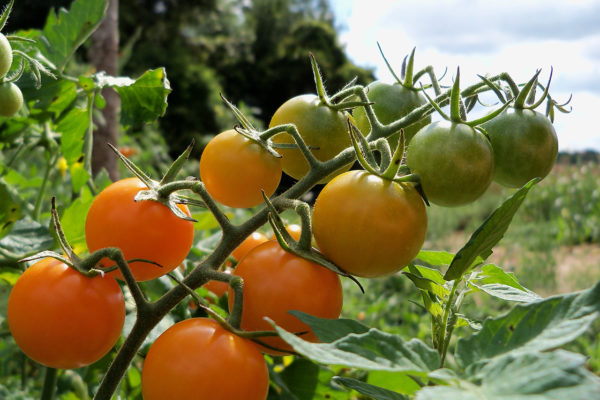
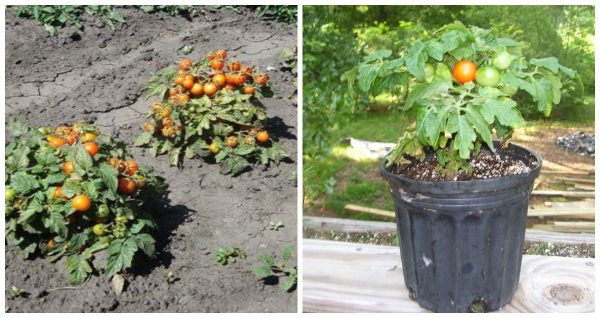
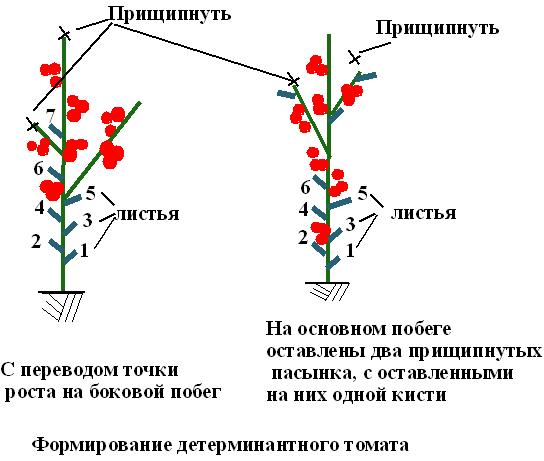
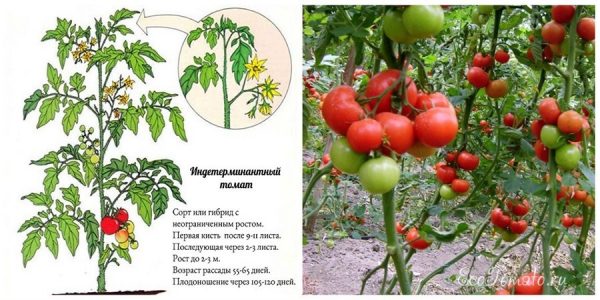
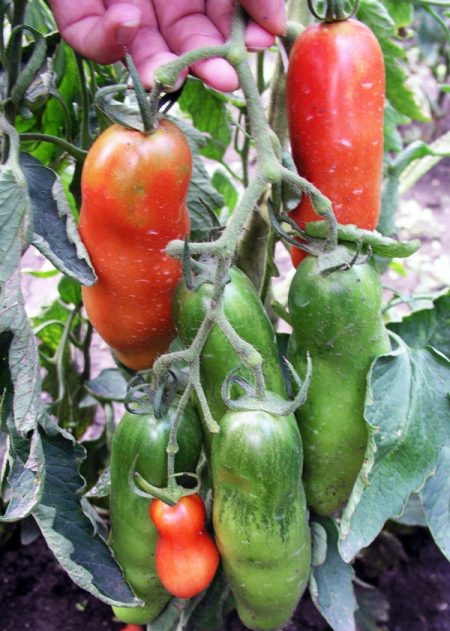
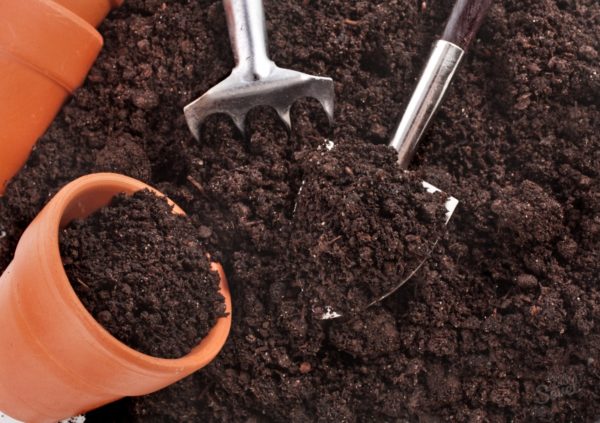
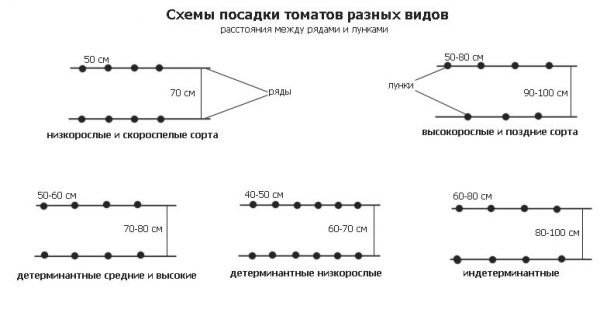
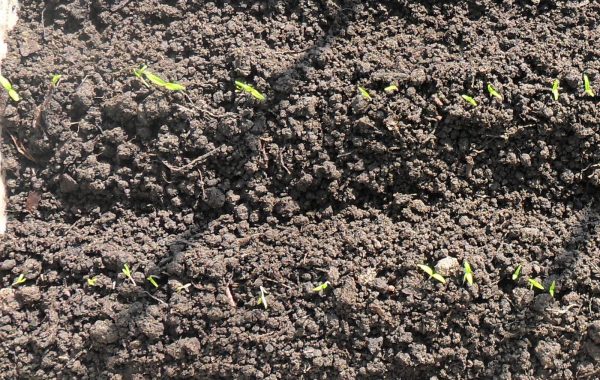
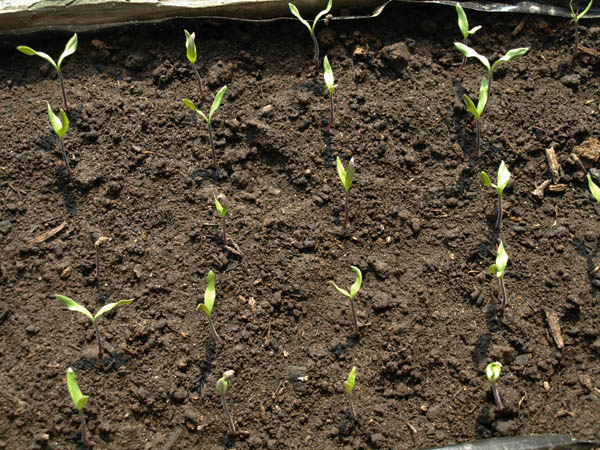
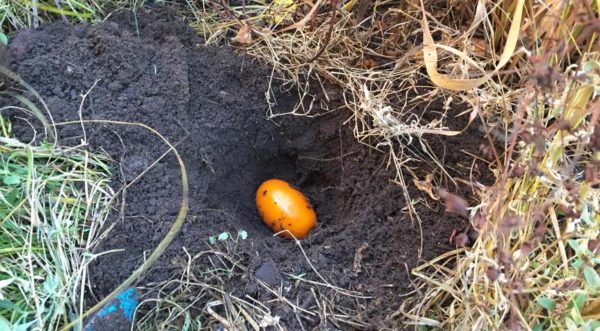


 (3 ratings, average: 3,67 out of 5)
(3 ratings, average: 3,67 out of 5) CUCUMBERS NEVER GET SICK, I'VE BEEN USING ONLY THIS FOR 40 YEARS! I SHARE A SECRET WITH YOU, CUCUMBERS ARE LIKE THE PICTURE!
CUCUMBERS NEVER GET SICK, I'VE BEEN USING ONLY THIS FOR 40 YEARS! I SHARE A SECRET WITH YOU, CUCUMBERS ARE LIKE THE PICTURE! You can dig a bucket of potatoes from each bush. Do you think these are fairy tales? Watch the video
You can dig a bucket of potatoes from each bush. Do you think these are fairy tales? Watch the video
 How our fellow gardeners work in Korea. There is a lot to learn and just fun to watch.
How our fellow gardeners work in Korea. There is a lot to learn and just fun to watch. Eye trainer. The author claims that with daily viewing, vision is restored. They don't charge money for views.
Eye trainer. The author claims that with daily viewing, vision is restored. They don't charge money for views. A 3-ingredient cake recipe in 30 minutes is better than Napoleon. Simple and very tasty.
A 3-ingredient cake recipe in 30 minutes is better than Napoleon. Simple and very tasty. Therapeutic exercises for cervical osteochondrosis. A complete set of exercises.
Therapeutic exercises for cervical osteochondrosis. A complete set of exercises. Which indoor plants match your zodiac sign?
Which indoor plants match your zodiac sign? What about them? Excursion to German dachas.
What about them? Excursion to German dachas.
Useful article. Especially for beginners. Any mistake can lead to crop loss.I usually stick to sowing 40+10 days before planting for early varieties, and 50+10 days for later varieties. Previously, there is no point in sowing, it will only waste time and energy for the plants.